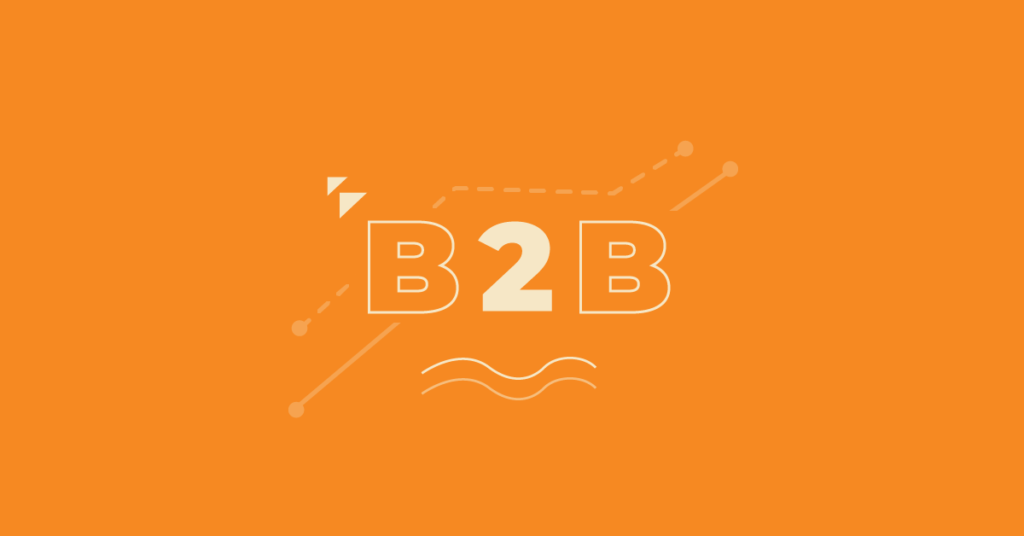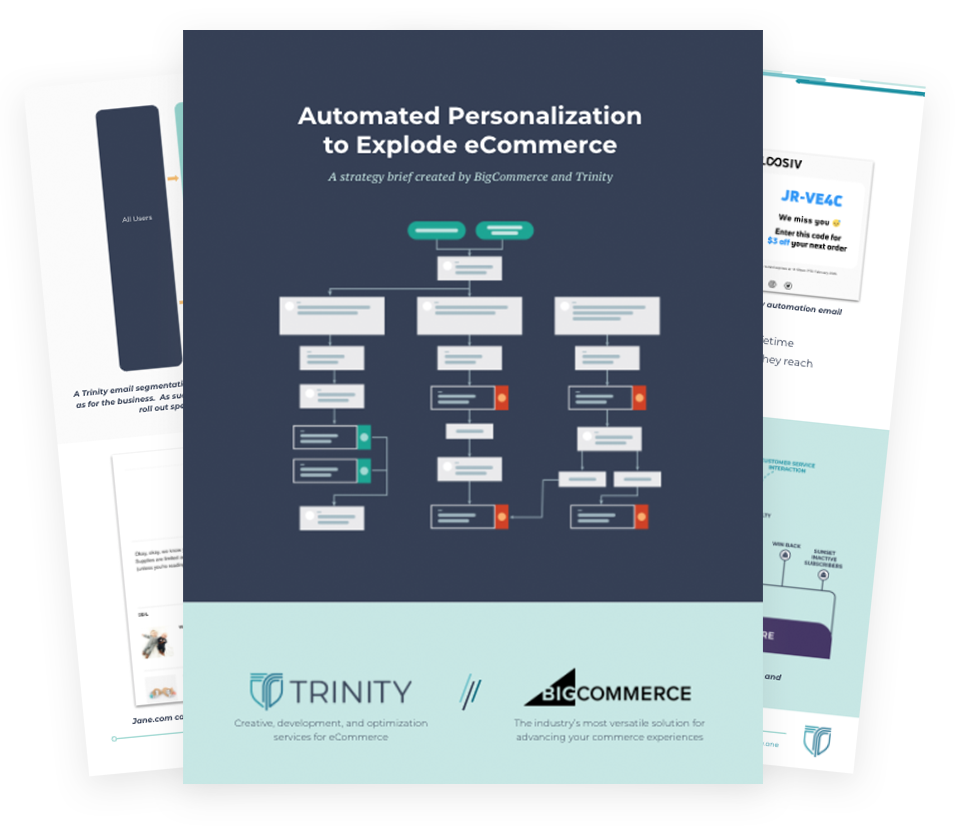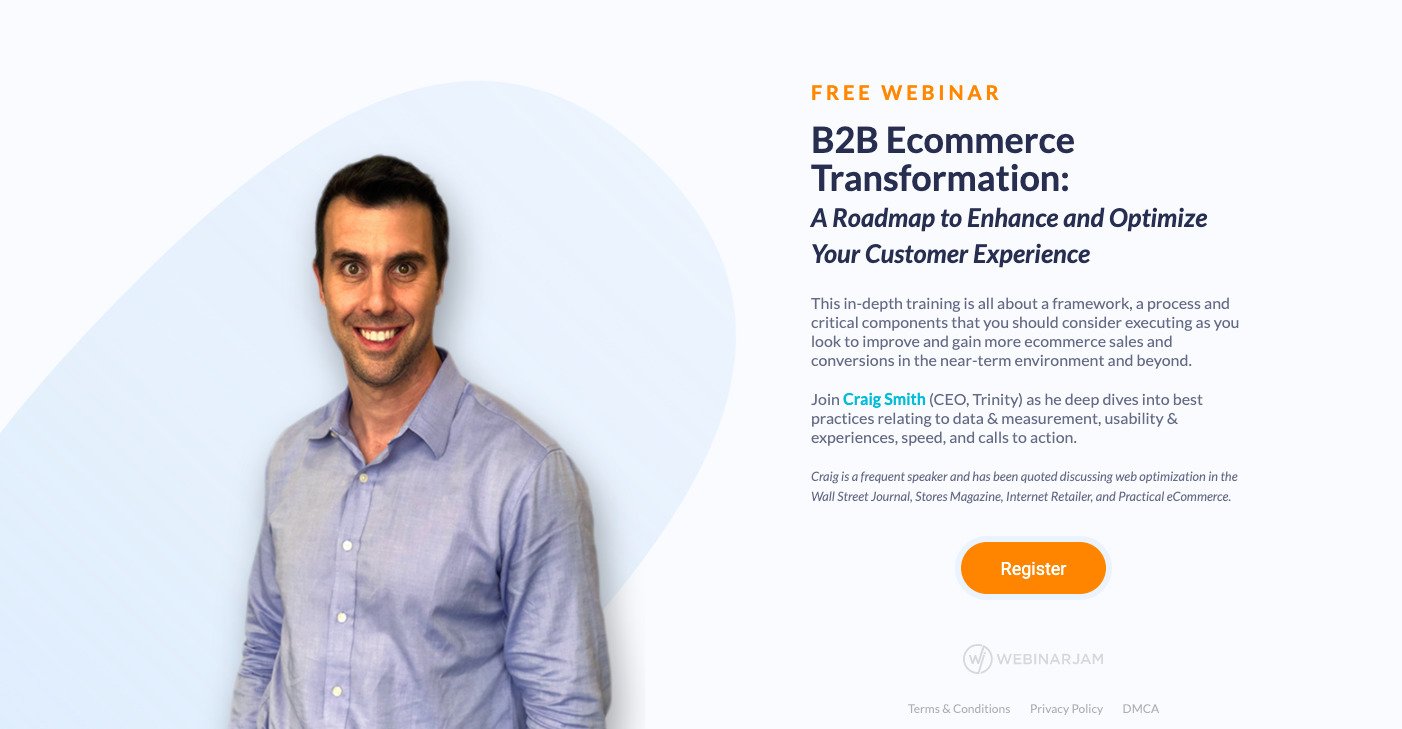Craig Smith:
Hi, welcome to the webinar. My name is Craig Smith, I’m the founder and CEO of Trinity, and today we’re going to be talking about B2B Ecommerce Transformation, a Roadmap to Enhance and Optimize Your Customer Experience. Today’s training is all about a framework, a process and critical components that you should consider and execute as you look to improve and gain more ecommerce sales and conversions in the near-term environment and beyond.
Real quick, as far as introduction goes about me, I’m the founder, again, of Trinity, I lead all corporate development and strategic vision. I have 18 years of ecommerce experience at eBay and Cigna, and I’m also a global speaker on ecommerce and digital topics. Real quick about Trinity, I founded the company back in 2006, and really what we are is we’re engineered to transform brand discovery and website experiences. We help companies get better-positioned in their markets so they can deliver more effective services and products to their end-customers.
Let’s now talk about focal areas for your B2B ecommerce business. Starting out, you want to make sure you’re considering data. Where are you tracking data, how are you tracking it, how are you integrating it, how are you consolidating it and utilizing it? You want to also consider your experience, how is your website performing today, and other channels performing? What are the benchmarks and patterns you’re seeing in user behavior, and what are you doing to create a memorable user experience?
Search engine optimization is also a critical factor within your B2B ecommerce business. You want to make sure that you have the proper technical foundation to deliver pages easily to Google so they can be indexed and served appropriately. You want to make sure your infrastructure and your speed of your website is performing very well, as well as having the appropriate content strategy to make sure you’re a leader in the core niches that you’re looking to serve.
Digital marketing is also very important. Make sure you have a feed of all your products, and that your products are categorized correctly, so you can make sure these products are advertised when people are searching for them. Email marketing is also another critical component, mainly around automation flows, and making sure that your business is using triggered and personalized messaging based upon clicks and based upon purchases to speak to customers in an ongoing fashion.
And the last focal area, and probably where we’ll spend of the time today talking about, is your platform, the design, the implementation, how you support it, how do you manage the business from a technical standpoint? All these components are critical and absolutely must be focused on to best-position your ecommerce business for growth.
Let’s look at some stats. So, at Trinity, we’re really seeing a B2B shift, that buyers are showing an affinity towards digital and ecommerce. In a recent study by BigCommerce, you see that 17% of B2B organizations who offer flexible payment options… Excuse me, they saw a 17% increase in sales. They also saw a 21% increase in average orders. 72% of B2B customers prefer the convenience of online purchasing, while 61% of B2B buyers use smartphones to research work purchases. It’s obvious ecommerce is only going to be gaining momentum and traction within these B2B buying segments.
Now with that, you want to make sure you have an omnichannel approach, that you’re selling through a call center, through your mobile device, through your website, through email, potentially through direct mail, and it all has to be orchestrated, and data has to be accurate regarding inventory levels and ownership. This type of sophistication is based upon an open system, and most customers and people we talk to are in this area over here. They’re still doing a lot of manual ordering input, they’re still using spreadsheets. You need to move to a mature backend operation that has an API architecture for orchestration, so product information management systems can handle pre-orders and feed to the right systems internally for pick, packing and shipping.
To do that, you need what’s called an open platform. This is a visual from, again, BigCommerce, one of our partners, showing some of the aspects you need to consider when you’re deploying your ecommerce platform for growth. Some of the top aspects, personalization, advanced merchandising, user-generated content, behavior-based promotions, all these things are the front-end, they’re going to be activated from the user interactions.
These middleware systems, like omnichannel and orders, cart checkout, this is all the data sources, and this has to integrate with other places. You can see BigCommerce uses a two-way REST API to just help systems in talking to each other, so now the ERP gets the orders, and orders also route to the appropriate other systems which business users and support staff leverage each day.
The next focal area to consider when you’re looking to optimize your ecommerce business in the B2B market is pricing and payments. Again, most B2B companies are pretty unsophisticated. They’re lacking the ability to do things like dynamic pricing, where you’re giving people pricing discounts based upon their order volume. Many systems also are missing PO and quick order capabilities. In implementing and transforming your ecommerce business, you’re going to make this weakness into a strength. Giving these types of additional functions, like multi-currency, multi-language, financing, price lists, et cetera, it’s going to make it more rewarding for your buying segment to shop on your site, and it’s going to make them come back.
Let’s show some examples that I thought were good to highlight for product flexibility. This company, Berlin Packaging, you can see that their catalog is very nuanced, there’s a lot of different options. There’s the capacity component, which has a plethora of sizes, and each size needs colors in terms of the container, and then there’s also the size of… Or the amount you’re going to purchase, and all this is dynamic in the pricing presentation. This is the type of presentation you want to deliver to your customers. You also want to consider content, and making sure that you have the right brand story. Your website, your new ecommerce platform, whatever you go with, needs to be extensible, where you can quickly create these types of pages that are going to associate to marketing campaigns, as well as associate to categories that might be shifting or changing.
After pricing, the next aspect is your experience. You need to have a beautiful, fast store that supports your offline sales by helping customers find what they want. Again, usually we see folks in this bucket, where they’re using an online catalog, but most orders are placed over the phone or through contact pages, and a lot of SKUs are presented without pricing. In moving forward to the mature aspect, you’re then going to have just a better navigational and searching experience, you’re going to help people find what they want faster. You’re going to accept quotes online, have resource centers, have customer service tools, data-driven merchandising, all the nuances that make the site almost feel like Amazon, and this really should be your goal. People love Amazon because it’s quick, easy, and familiar. Try to achieve the same thing within your B2B ecommerce experience.
All right, well now those were some of the areas to consider when you’re doing your planning, well now let’s talk about the project components, what are the things you need to do to bring your next generation store to life? There really is three core phases, the first is branding and research, in which you’re going to research and develop your new look and feel, what is the new brand? The second is a customer experience architecture planning process, in which you’re trying to simplify the experience and simplify ordering. This has to correspond with a lot of data definition and diagramming to support development. And then lastly is development, that’s building it out, creating and refining the world-class website, so now your customers will come into your front door impressed and ready to buy.
An area that’s frequently missed is personas. We highly recommend that as you look at your segments of customers, construct personas for them before you do any design or build-out. In this example, we’re showing Mark, a lead engineer who has worked with his company for 18 years, and is tasked with overseeing all parts purchasing. By doing this, it gives the creatives on your team the ability to kind of think outside the box, and then start understanding what type of messaging and presentations will be more effective for someone like Mark.
After personas, you move to branding. This is what we call a mood board. It’s showing imagery, it’s showing font types, it’s showing colors and logos, to kind of say, “Hey, this is what we’re going after,” and by showing this imagery style and colors, and getting consensus among your business staff, it’s going to really eliminate confusion down the line when you’re trying to get the right look and feel for your store. So, highly recommend to create a mood board for your ecommerce project.
You also want to have guidelines. In this case, this company we worked with, they really wanted to have illustrations as a big part of their presentation, and we created a variety of illustrations that they could choose from, and that we would utilize within their website. You want to have these types of guidelines as mapped out as possible so that again, you have the right assets and creatives for stakeholders in your company to make choices upon, and to help in building.
After that, you then go to an initial look and feel, where you’re now constructing the header, the footer, and typically the homepage. These are what we call global elements, at least the header and footer are. They’re rendering throughout the site on any page you land on or navigate to, and they’re extremely important. This initial look and feel is the general theme of the approved mood board that you previously constructed, and this design lays the foundation for the rest of your site.
After look and feel, then move your conceptual designs. This is creating your ecommerce templates based upon the look and feel that was previously constructed. They need to serve as blueprints for when you build out these creatives into static HTML that integrates with your platform, and these also need to be done both for mobile and for desktop. I recommend look at the industry, look at best practices in your category, but we’ve seen great success with B2B companies embracing more B2C design trends on product pages, category pages, and within search and navigation functionality.
Another key piece of any ecommerce transformation project is your data. What needs to be done is what you’re looking at right here, this is a data map. It’s showing all the current parameters in terms of aspects of the data that is in the current system, and in this case, we’re mapping it to BigCommerce. Each element needs to have a corresponding element if we’re looking to move it over, and drawing these lines and making sure we have this map makes it a very simple process to move data from point A to point B, and also enable different types of kitting, and other classification things that we want to achieve with the data and the products.
After we have the map, it migrates over. The data migrates, pricing, product titles, SKU numbers, inventory, and then we also [inaudible 00:12:42] to migrate content, buyer’s guides, informational one-sheeters, blog content. But this also gives you a great opportunity to then map this content to SEO best practices, making sure that the content has targeted metadata, that the product descriptions are unique. Definitely invest at this stage in new, fresh content, as it’s going to help Google and help search engines better trust and render your site for competitive search queries.
Next is QA. QA is extremely important. It needs to go across three different disciplines, in my opinion. The first is engineering, the people who built it, they need to test it, and across every browser type and phone and tablet. The design team as well, the folks who designed it, they need to review it, and then lastly, people who aren’t in marketing or design, or even engineering, need to do it and test it. Your customer service folks, finance, accounting, it really should be a group project.
When your site goes live, or before your site goes live, you must consider ecommerce optimization touchpoints, and here’s just a few of them that are really important to build into your site experience. The first is a subscriber welcome. When someone comes to your site and maybe they’re not buying, but they’re ready to give an email address for a… Maybe a coupon, maybe a sign up for a webinar, maybe sign up for some type of free content of some sort, whatever it may be, you need to have a mechanism to collect the email address.
Now, that user leaves, but once they’ve given you their email address, you now have it, you can then cookie them, which means when they come back, see that they came back, and now send them a browse abandonment email. They looked at this robotic part and they didn’t buy it? Send them a part, “Hey, you forgot to check out, can we help with anything?” A very effective way to bring people back to your store. Also, look at cart abandonment emails. How can you send emails that are efficient and effective when people add to cart to get them to come back and complete their order?
New customer thank you and onboarding series are extremely important, making sure the customer knows your history, your value proposition, how you can help with future needs and purchases, as well as any follow-up information relating to the products they currently bought. If possible, send a review request, depending on your category, and then also upsell and cross-sell, VIP and loyalty efforts, this is all based around trying to get the customer back in the fold, and this should be a two-pronged approach, also including a physical sales team.
You want to make sure you do custom automation with your brand. This following graphic is a custom sample workflow with a B2B customer, that really is sending out information and personalized emails relating to post-purchase engagement, depending upon what happens. Did they get a review, did they not? Has the order been delivered, has the order been… Have they been back since, have they bought since? And all this data is going to do is trigger off future messages, in this case, reminding the user to come back to the website and order more gloves.
When you’re doing your marketing planning, make sure you’re creating segments of customers. Using the RFV, recency, frequency, and value modeling, you can target a core audience, a win-back audience, and maybe a caution and avoid audience as well. And these audiences are bucketed in your systems, and then you can speak to folks in different manners. For example, maybe someone is recent, frequent, and high-value, this is your top segment. Treat this customer differently than someone that has come for the first time in the last six months.
Here is a ballpark timeline for your ecommerce transformation project. They typically last between six to eight months, in which you have these key milestone check-ins to really understand where you’re at and where you’re going. Here’s an example from ones we’ve done in the past. You can see that initial four months really geared around the experience, the latter four months really geared around build-out and integrations. Now that being said, these timelines are always compressed based upon internal schedules, resources available, and also the level of aggressiveness a company has to get it live.
All right, so, some final thoughts. When you’re approaching your ecommerce transformation, make sure you do so with broad understanding in your C-suite. Make sure your CEO and your COO and your CIO are all aligned on the program, and the nuances and milestones of the project. Be sure to invest in data, understanding what data you have, where it needs to go, how it needs to integrate. Make sure you invest in design, you’re creating this new experience that’s going to wow your customers. And make sure you choose the right platform for your needs, that it has the functionality requirements specific for B2B.
I want to thank you very much for this training today, I hope you learned a couple things. For a complimentary review of your ecommerce business conducted by Trinity or myself, please email me. You can reach me at [email protected], and we’ll go through your site, we’ll go through some… The site through a variety of tools and look at it with a lens of marketing and optimization to give you some ideas of where you can grow. Again, thank you so much for joining… Or joining the webinar today. Have a great rest of the day, and we’ll see you soon, bye-bye.





